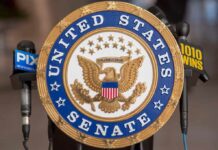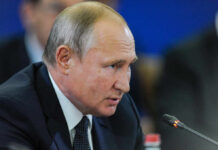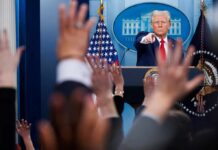
China’s unprecedented display of its full nuclear triad at the 2025 Victory Day parade signals a bold challenge to U.S. strategic dominance.
Story Snapshot
- China publicly unveiled land-, air-, and sea-launched nuclear missiles, confirming a modernized nuclear triad.
- The parade marked a rapid and massive expansion of China’s nuclear arsenal and missile capabilities since 2020.
- Strategic messaging targeted the U.S., with Russian and North Korean leaders in attendance, highlighting adversarial alignment.
- Experts warn of heightened arms race risk, destabilized deterrence, and potential erosion of U.S. influence in the Asia-Pacific.
China’s Nuclear Triad on Display: A Strategic Warning
On September 3, 2025, Beijing’s streets were the stage for a display unseen in Chinese history: the full public exhibition of China’s nuclear triad—land-based intercontinental ballistic missiles, air-launched nuclear cruise missiles, and submarine-launched ballistic missiles. This parade, commemorating the 80th anniversary of World War II’s end, marked the first time China broadcasted its comprehensive nuclear capabilities to the world. The event was not merely ceremonial; it was a deliberate act of strategic signaling, intended to deter American intervention in regional conflicts and assert China’s emergence as a peer nuclear power. With the DF-61 ICBM and advanced missile technologies on display, the message was clear: China’s nuclear arsenal has evolved from minimal deterrence to a robust, diversified force capable of challenging U.S. supremacy.
🇨🇳 China just staged the largest military parade in its history, including nuclear weapons and its full arsenal on display.
On the grandstand: Xi Jinping, Vladimir Putin, and Kim Jong-un.A message to the world: strength and unity on full display pic.twitter.com/NLjVDreDO3
— RealidadDirecta (@RealidadDirect) September 3, 2025
From Opacity to Overt Power: The Road to 2025
For decades, China’s nuclear doctrine emphasized a small, survivable arsenal and a “no first use” pledge. This posture changed dramatically after 2020, as China accelerated its nuclear buildup, constructing large missile silo fields and more than doubling its warhead count. Western intelligence and open-source analysts tracked these developments despite official Chinese denials and disinformation campaigns. The 2025 parade’s timing—amid escalating U.S.-China tensions over Taiwan and the South China Sea—underscored the growing strategic rivalry. The presence of Vladimir Putin and Kim Jong Un highlighted a new axis of adversaries, united in their desire to counter U.S. influence and project strength on the world stage.
Watch: China Reveals New Futuristic Weapons At Victory Day Parade 2025
Key Players and Strategic Calculations
At the heart of this demonstration stands the Chinese Communist Party, led by President Xi Jinping, who has centralized authority over military and nuclear policy. The People’s Liberation Army’s Rocket Force, Navy, and Air Force each presented their nuclear capabilities, confirming operational status across all three legs of the triad. For the United States, the implications are profound: the Department of Defense and allied planners must now contend with a far more complex and survivable Chinese nuclear force. The parade’s guest list made the power dynamics explicit, as alignment between China, Russia, and North Korea signals a coordinated effort to undermine U.S. extended deterrence and shift the regional balance of power.
Rapid Modernization and Advanced Technologies
The military hardware on display—DF-61 ICBMs, JL-3 submarine-launched missiles, and air-launched nuclear cruise missiles—underscored the sophistication of China’s modernization efforts. Beyond nuclear arms, China showcased hypersonic weapons, AI-powered drones, and cyber warfare units, demonstrating capabilities designed to neutralize American technological advantages. Chinese officials touted national strength and progress, while Western analysts interpreted these moves as escalatory, warning of a destabilizing arms race. Current estimates place China’s nuclear arsenal at around 600 warheads, with projections of over 1,000 by 2030, signaling a determination to achieve strategic parity with the U.S. and erode traditional American deterrence.
Risks, Reactions, and the Path Ahead
The short-term fallout includes heightened anxiety among U.S. allies and rapid reassessment of regional missile defenses. American and allied military planners face new uncertainties, as China’s expanded arsenal complicates traditional deterrence and response options. The longer-term danger is the potential unraveling of global arms control norms, as the world’s nuclear order grows more unstable.
Limited transparency from Beijing and ongoing disinformation campaigns further complicate efforts to gauge the true extent of China’s capabilities, leaving the U.S. and its allies to confront a rapidly changing threat landscape. As China’s nuclear arsenal grows and its partnerships with Russia and North Korea deepen, the stakes for American security, constitutional values, and the global order have never been higher.
Sources:
Nuclear Weapons at China’s 2025 Victory Day Parade – Federation of American Scientists (FAS)
Parading China’s Nuclear Arsenal Out of the Shadows – Center for Strategic and International Studies (CSIS)
China’s Military Technology at Victory Day Parade: U.S. Analysts React – DefenseScoop
2025 China Victory Day Parade – Wikipedia
Understanding China’s Victory Day Military Parade: Politics, Strength, and Narrative – Australian Outlook
China’s Military Parade – CSIS Event

























